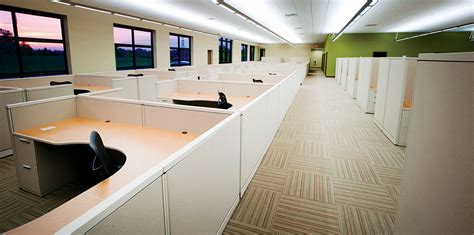In the contemporary workplace, open office designs have gained popularity. However, the lack of privacy and distractions associated with these environments have prompted a growing demand for more enclosed and private workspaces. Cubicles with doors offer a solution to this challenge, combining the benefits of both open and private office layouts.

Benefits of Cubicles with Doors
- Enhanced Privacy: Doors provide visual and acoustic barriers, creating a sense of privacy and reducing distractions. This allows employees to focus on their work without being disturbed by colleagues or workplace noise.
- Reduced Noise Levels: Cubicles with doors act as a sound barrier, effectively reducing noise levels in the workspace. This can improve concentration, productivity, and overall well-being.
- Flexibility and Customization: Cubicles with doors can be customized to meet individual needs. They allow for the addition of personal touches, such as artwork or plants, creating a more comfortable and personalized workspace.
- Improved Collaboration: While doors provide privacy, they do not completely isolate employees. They can interact with colleagues as needed, while still maintaining a private space for focused work.
- Increased Productivity: Studies have shown that employees working in cubicles with doors experience higher levels of productivity than those in open office environments. Privacy and reduced distractions contribute to improved focus and efficiency.
Applications of Cubicles with Doors
Cubicles with doors are versatile and can be utilized in a wide range of industries and office settings. Some common applications include:
- Call Centers: Call center agents require privacy to conduct confidential conversations and handle sensitive information. Cubicles with doors provide a quiet and distraction-free environment for these tasks.
- Healthcare Settings: Healthcare professionals need private spaces to consult with patients, conduct examinations, and maintain patient confidentiality. Cubicles with doors create a secure and comfortable setting for these interactions.
- Educational Institutions: Libraries, tutoring centers, and other educational spaces benefit from cubicles with doors. They provide students with private study areas, reducing distractions and promoting focus.
- Creative Workspaces: Architects, designers, and other creative professionals require spaces for brainstorming and collaboration. Cubicles with doors allow for privacy and undisturbed thought processes, while still facilitating teamwork.
- Specialized Workplaces: Laboratories, clean rooms, and other specialized workplaces require controlled environments. Cubicles with doors provide a secure and isolated space for these activities.
Design Considerations for Cubicles with Doors
When designing cubicles with doors, several factors should be considered:
- Layout: Determine the optimal layout of cubicles to ensure efficient space utilization and accessibility. Consider factors such as traffic flow, natural light, and proximity to resources.
- Materials: Choose materials that provide soundproofing, durability, and aesthetics. Consider options such as fabric-covered panels, glass partitions, or solid wood panels.
- Door Design: Select doors that are suited to the specific needs of the workspace. Consider factors such as size, style, and hardware.
- Ventilation: Ensure that cubicles with doors have adequate ventilation to maintain air quality and comfort for occupants.
- Customization Options: Offer customizable options such as adjustable desk heights, storage compartments, and personal touches to enhance employee comfort and productivity.
Benefits of Cubicles with Doors According to Customers
“The privacy provided by my cubicle with a door has significantly reduced distractions and improved my focus. I am able to get more work done in a shorter amount of time.” – Employee in a call center
“As a therapist, I appreciate the confidentiality that my cubicle with a door provides. My clients feel more comfortable sharing personal information in a private setting.” – Healthcare professional
“The adjustable desk height in my cubicle allows me to work comfortably and maintain good posture. The storage compartments keep my workspace organized and clutter-free.” – Architect
FAQs about Cubicles with Doors
-
Q: Are cubicles with doors more expensive than traditional cubicles?
A: The cost of cubicles with doors can vary depending on factors such as materials, size, and customization options. However, they generally offer a higher return on investment due to increased productivity and employee satisfaction. -
Q: Do cubicles with doors completely isolate employees?
A: While cubicles with doors provide privacy, they do not completely isolate employees. They can interact with colleagues as needed, through the door or by stepping outside their cubicle. -
Q: How can cubicles with doors be made more sustainable?
A: Choose cubicles made from recycled materials, use energy-efficient lighting, and incorporate natural ventilation to reduce their environmental impact. -
Q: What is a “croffice”?
A: A “croffice” is a creative term used to describe a cubicle with a door that is large enough to accommodate a small office or workstation. -
Q: How can cubicles with doors be made more accessible?
A: Ensure that cubicles with doors are wheelchair accessible and have adjustable desk heights to accommodate employees of different abilities. -
Q: What is the optimal size for a cubicle with a door?
A: The optimal size for a cubicle with a door depends on the nature of the work being done. Consider factors such as storage needs, equipment requirements, and the number of occupants. -
Q: Can cubicles with doors be used in open office environments?
A: Yes, cubicles with doors can be incorporated into open office environments. They provide a balance between privacy and collaboration, allowing employees to work independently and interact as needed -
Q: How can cubicles with doors be customized to meet individual needs?
A: Cubicles with doors can be customized with various options such as adjustable desk heights, fabric colors and patterns, storage compartments, and personal touches such as artwork or plants.
